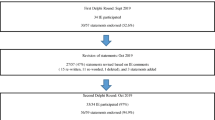Abstract
Purpose
Lambdoid synostosis (LS) is a rare condition, which is either isolated; associated with sagittal synostosis, the “Mercedes-Benz” syndrome (MBS); or with synostosis of the coronal sutures (oxycephalic form). In addition, LS is part of the phenotype of a growing number of genetic diseases. The nosology, pathophysiology, and management are controversial. We decided to review our experience with LS.
Methods
We reviewed retrospectively pediatric cases of LS proved on CT-scanner, isolated or associated with other conditions, followed in our craniofacial center during the last 15 years, regarding clinical presentation, anatomical lesions, syndromic associations, surgical management, and outcome.
Results
We reviewed 48 cases: 6 isolated LS, 22 MBS, and 20 oxycephalic. A syndromic context was present in 72% (up to 80% of oxycephalic cases), and faciostenosis was present in 23%, mostly oxycephalic cases (40%). Transverse sinus agenesis was found in 61% of documented patients. A total of 31% of children had a dystocic birth, up to 45% of MBS. Decompressive craniectomy or cranioplasty was needed in a majority of patients, often young infants, while posterior fossa decompression was mostly performed in older children.
Conclusion
LS is rarely isolated and non syndromic; most cases are found in a wide spectrum of diseases, and LS is often associated with sagittal or coronal synostosis. Genetic evaluation is mandatory for LS; conversely, geneticists may require neurosurgical advice for LS in an increasing number of very rare diseases. The surgical management of LS should be tailored according to clinical presentation, age, and syndromic context.








Similar content being viewed by others
Data availability
Data and material are stored and will be made available upon request.
References
Al-Jabri T, Eccles S (2014) Surgical correction for unilateral lambdoid synostosis: a systematic review. J Craniofac Surg 2014:1266–1272. https://doi.org/10.1097/SCS.0000000000000961
Moore MH, Abbott AH, Netherway DJ, Menard R, Hanieh A (1998) Bilambdoid and posterior sagittal synostosis: the Mercedes Benz syndrome. J Craniofac Surg 9:417–422. https://doi.org/10.1097/00001665-199809000-00003
Goodrich JT, Argamaso R (1996) Lambdoid stenosis (posterior plagiocephaly) and craniofacial asymmetry: long-term outcomes. Childs Nerv Syst 12:720–726. https://doi.org/10.1007/BF00366157
Chivoret N, Arnaud E, Giraudat K, O’Brien F, Pamphile L, Meyer P et al (2018) Bilambdoid and sagittal synostosis: report of 39 cases. Surg Neurol Int. 9:206. https://doi.org/10.4103/sni.sni_454_17
Pillai S, Cochrane D, Singhal A, Steinbok P (2013) Bilateral lambdoid and posterior sagittal craniosynostosis - management, evolution, and outcome. Childs Nerv Syst 29:2117–2121. https://doi.org/10.1007/s00381-013-2155-z
Fearon JA, Dimas V, Ditthakasem K (2016) Lambdoid craniosynostosis: the relationship with Chiari deformations and an analysis of surgical outcomes. Plast Reconstr Surg 137:946–951. https://doi.org/10.1097/01.prs.0000480014.18541.d8
Vinchon M, Pellerin P, Baroncini M, Wolber A, Dhellemmes P (2012) Non-syndromic oxycephaly and brachycephaly: a review. Childs Nerv Syst 28:1439–1446. https://doi.org/10.1007/s00381-012-1800-2
Coeugniet E, Dhellemmes P, Vinchon M, Wolber A, Pellerin P (2012) Midfacial distraction without osteotomy using a transfacial pin and external devices. J Craniofac Surg 23:184–189. https://doi.org/10.1097/SCS.0b013e3182418f80
Vinchon M (2019) Surgery for Chiari 1 malformation: the Lille experience. Childs Nerv Syst. 35:1875–1880. https://doi.org/10.1007/s00381-019-04242-9
Balestrino A, Secci F, Piatelli G, Morana G, Pavanello M, Pacetti M, Cama A, Consales A (2019) Pure bilateral lambdoid and posterior sagittal synostosis (Mercedes-Benz Syndrome): case report and literature review. World Neurosurg 128:77–82. https://doi.org/10.1016/j.wneu.2019.04.117
Hing AV, Click ES, Holder U, Seto ML, Vessey K, Gruss J, Hopper R, Cunningham ML (2009) Bilateral lambdoid and sagittal synostosis (BLSS): a unique craniosynostosis syndrome or predictable craniofacial phenotype? Am J Med Genet A 149A:1024–1032. https://doi.org/10.1002/ajmg.a.32782
Haas-Lude K, Wolff M, Will B, Bender B, Krimmel M (2014) Clinical and imaging findings in children with non-syndromic lambdoid synostosis. Eur J Pediatr 173:435–440. https://doi.org/10.1007/s00431-013-2186-1
Shahinian HK, Jaekle R, Suh RH, Jarrahy R, Aguilar VC, Soojian M (1998) Obstetrical factors governing the etiopathogenesis of lambdoid synostosis. Am J Perinatol 15:281–286. https://doi.org/10.1055/s-2007-993943
Borad V, Cordes EJ, Liljeberg KM, Sylvanus TS, Lim PK, Wood RJ (2019) Isolated lambdoid craniosynostosis. J Craniofac Surg 30:2390–2392. https://doi.org/10.1097/SCS.0000000000006058
Taylor WJ, Hayward RD, Lasjaunias P, Britto JA, Thompson DNP, Jones BM, Evans RD (2013) Enigma of raised intracranial pressure in patients with complex craniosynostosis: the role of abnormal intracranial venous drainage. Childs Nerv Syst 29:2117–2121
Swanson J, Oppenheimer A, Al-Mufarrej F, Pet M, Arakawa C, Cunningham M, Gruss J, Hopper R, Birgfeld C (2015) Maternofetal trauma in craniosynostosis. Plast Reconstr Surg 136:214e–222e. https://doi.org/10.1097/PRS.0000000000001468
Vinchon M (2019) The metopic suture: natural history. Neurochirurgie 65:239–245. https://doi.org/10.1016/j.neuchi.2019.09.006
Smartt JM Jr, Reid RR, Singh DJ, Bartlett SP (2007) True lambdoid craniosynostosis: long-term results of surgical and conservative therapy. Plast Reconstr Surg 120:993–1003. https://doi.org/10.1097/01.prs.0000278043.28952.e8
Author information
Authors and Affiliations
Contributions
All the authors made contribution in the collection of clinical data, discussions, and redaction of this manuscript.
Corresponding author
Ethics declarations
This is a retrospective, observational study that requires no ethics approval. Consent to participate was given by the parents of patients photographed in Figs. 1, 2, 3, and 7.
We the authors give our consent for publication and will transfer copyright upon acceptance. Material used for Figs. 7 and 8 has been published online on a proprietary website and is not submitted to copyright.
Conflict of interest
We the authors declare no funding, no conflicts of interest, and no competing interests.
Additional information
Publisher’s note
Springer Nature remains neutral with regard to jurisdictional claims in published maps and institutional affiliations.
Rights and permissions
About this article
Cite this article
Vinchon, M., Guerreschi, P., Karnoub, MA. et al. Synostosis of the lambdoid suture: a spectrum. Childs Nerv Syst 37, 1991–2000 (2021). https://doi.org/10.1007/s00381-020-05003-9
Received:
Accepted:
Published:
Issue Date:
DOI: https://doi.org/10.1007/s00381-020-05003-9




